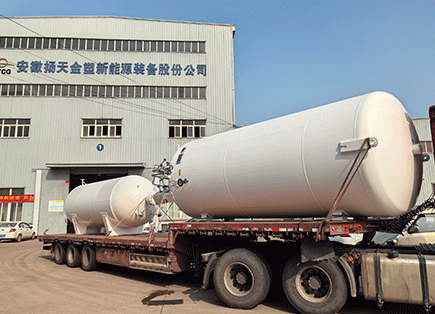Low temperature liquid storage tanks, the structure and type of low-temperature liquid storage tanks, have become increasingly popular in the low-temperature liquid market in recent years. The sales of liquid oxygen, liquid argon, liquid nitrogen, liquid carbon dioxide, LNG, and natural gas have increased significantly. Therefore, the by-products of oxygen concentrators generate considerable profits and have become an important part of non steel product income for steel enterprises. The production, storage, and transportation of low-temperature liquids cannot be separated from insulated storage tanks, which are widely installed and used.

When the storage tank is in working condition, there are potential dangers such as leakage, overpressure, and explosion. If these hidden dangers are not discovered and dealt with in a timely manner before these accidents occur, they will develop into serious accidents. Therefore, it is very important to establish a comprehensive inspection system and implement it seriously to ensure the safe operation of storage tanks. The daily inspection of storage tanks mainly includes the following contents:
Whether the valves and pipelines are leaking, and whether the shell is frosting or sweating.
Are all valves in normal open and closed state.
Are the instruments (level gauges, pressure gauges) working properly, and are the DCS display parameters consistent with
the onsite primary gauge.
Is the pressure in the storage tank normal? When the pressure approaches or equals the maximum pressure, the vent
valve should be opened to release the pressure.
Does the liquid filling rate exceed 95%.
Is the sealing gas normal for the atmospheric pressure powder insulated storage tank. (50mmH2O)
Flammable, explosive materials and all debris are strictly prohibited from being placed near the liquid oxygen storage tank.
Smoking and open flames are strictly prohibited near the liquid oxygen storage tank.
At least once a week, the acetylene and total hydrocarbon content in the liquid oxygen stored in the tank should be tested, and the acetylene content should not exceed 0.1 × 10 ^ 3
10-6 (v/v), if exceeded, liquid oxygen must be promptly discharged for replacement treatment.
Is the grounding of the liquid oxygen storage tank good.
If it is not used for a long time, it is necessary to ensure that there is a certain amount of liquid in the tank to avoid using it for a long time by re cooling and replacing the tank.
Whether the supporting legs are damaged, whether the foundation sinks, tilts, or cracks, whether the fastening bolts are intact, and whether the tank body is deformed.
Regularly check the vacuum level of the storage tank.
Copyright © 2024, Inc.All rights reserved. © Anhui Yangtian Jinsu New Energy Equipment Co., Ltd. All rights reserved. Anhui ICP No. 2021003498